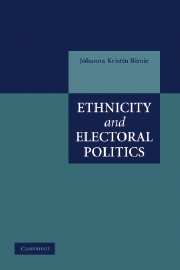Book contents
- Frontmatter
- Contents
- List of Tables and Figures
- Acknowledgments
- 1 Introduction: The Ethnic Effect
- 2 Ethnic Attractors
- 3 Ethnic Attractors and Exogenous Constraints
- 4 Ethnic Voting in Romania
- 5 Ethnic Voting and Party System Stability
- 6 Ethnic Politics and Access
- 7 The Ethnic Effect on Regime Stability
- 8 Conclusions
- Appendix A The Model (Formal Version)
- Appendix B Measurements and Other Methods Issues
- References
- Index
Appendix B - Measurements and Other Methods Issues
Published online by Cambridge University Press: 03 December 2009
- Frontmatter
- Contents
- List of Tables and Figures
- Acknowledgments
- 1 Introduction: The Ethnic Effect
- 2 Ethnic Attractors
- 3 Ethnic Attractors and Exogenous Constraints
- 4 Ethnic Voting in Romania
- 5 Ethnic Voting and Party System Stability
- 6 Ethnic Politics and Access
- 7 The Ethnic Effect on Regime Stability
- 8 Conclusions
- Appendix A The Model (Formal Version)
- Appendix B Measurements and Other Methods Issues
- References
- Index
Summary
TESTS OF VOTE STABILITY IN CHAPTERS FIVE AND SEVEN
There is little consensus as to what makes a democracy. The meaning of the word varies from Huntington's (1991) definition, which hinges on a popular election of the executive and suffrage of half of all adult males, to Diamond's (1996) description of liberal democracies, which includes conditions such as a free and independent press, political equality of citizens, and multiple and ongoing channels and means of expressing interests. Because the objective of this book is to gauge the effects of the voting behavior of particular social groups on the development of new party systems, it is imperative that all members of society are allowed to participate freely and that elections are competitive, free and fair. Therefore, I include all new procedural democracies that are considered free and fair by international observers. New refers to any newly established democracy, whether the previous authoritarian regime resulted from domestic events or foreign control.
In addition, the country must have universal suffrage without significant restrictions such as gender or literacy requirements. The reason for this last criterion is that the very ethnic populations that are the subject of interest here often have been excluded from democratic participation through a variety of suffrage requirements. Such requirements often coincide with economic class, and ethnic populations in many cases have constituted the very economic class most excluded by these requirements.
- Type
- Chapter
- Information
- Ethnicity and Electoral Politics , pp. 225 - 252Publisher: Cambridge University PressPrint publication year: 2006



